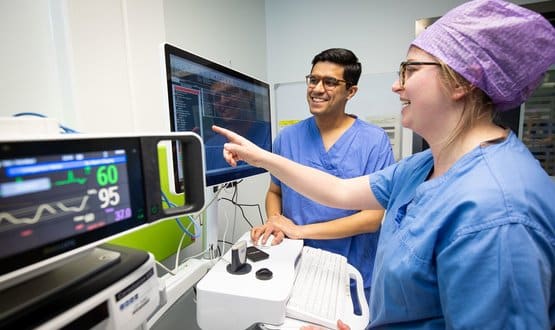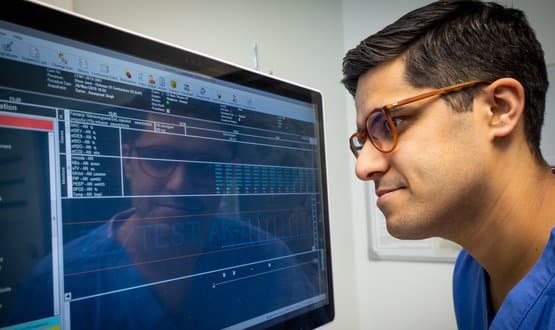Last November, global digital exemplar Royal Free London NHS Foundation Trust went live with a brand new electronic patient record. For Hannah Crouch, a visit to the trust underscores the difference clinician-led digitisation can make – and what it means to be a GDE.
When I joined Digital Health News as a reporter in October 2017, one of the first things I was told about was a selection of trusts that had been given a pot of money to advance digitisation.
The global digital exemplars (GDEs) are NHS England’s flagship digital programme, intended to produce blueprints which other trusts can use as a guide when implementing technology.
After having written so much about the GDEs – not to mention talking endlessly about them to various people over the phone and at events – I jumped at the chance to visit one.
Staff at Royal Free London NHS Foundation Trust invited me to visit Chase Farm Hospital, dubbed a ‘digital hospital’ by the trust.
The hospital, located in north London, has recently been redeveloped. In November 2018, it reopened its doors, complete with a new EPR system – which simultaneously went live at Barnet Hospital, Edgware Community Hospital, Finchley Memorial Hospital and the maternity department at the Royal Free Hospital.
The EPR was implemented in 11 months as part of a ‘big bang’ go live.
Royal Free acquired Barnet and Chase Farm Hospitals NHS Trust in 2014. Both trusts ran Cerner Millennium systems, but the latest go live has meant they could both join up onto one Cerner system.

Owning the system
Interview anyone about the ingredients for success in an EPR implementation, and you’ll hear a lot about the idea of clinical engagement.
But walking around the wards at Chase Farm with Amanpreet Sarna – chief medical information officer (CMIO) and anaesthetic registrar – and with chief nursing information officer (CNIO) Katie Trott, I was able to see first-hand just what that means.
It was clear how proud staff were of the system they have created. There was also a sense they have real ‘ownership’ of the EPR.
Amanpreet, for instance, told me how the anaesthetic module of the system was co-designed by him and his colleagues.
Using a dummy patient, he demonstrated how it’s now possible to seamlessly move between clinical systems without having to log on at different computers with various logins.
Now paper-free, clinicians in the department can view all patient information in real time. That includes information from monitoring equipment, which is all integrated with the EPR – meaning anaesthetists can spend time interpreting data rather than writing it down.
Katie emphasised the importance of staff engagement too. She explained how the EPR can easily be updated and reconfigured, with clinicians even given the option to pick their own colour preferences to suit their own tastes. That means they can personalise what they see on the screen.
The trust also regularly holds meetings with staff where they can talk about their experiences with the EPR and what additions they would like to be made.
Money, money, money
Clinical engagement may be crucial, but the reality is that money makes many things easier in life. EPRs are no exception. While it has not been disclosed how much was spent on the Royal Free’s new system, it is the case that the money from the GDE programme – £10 million, which organisations were expected to match fund – went towards the new Cerner EPR.
When I speak to Glenn Winteringham, group chief digital officer at the trust, he does admit the funding has been a key factor in supporting the trust’s digitisation.
And he appreciates that non-GDEs face a catch-22: financial strains meaning they would not be able to cough up the millions of pounds for a new EPR system that would make them more digitally advanced.
But he does not buy the argument that the GDE programme just further increases the gap between the digital haves and have nots. Instead, he says it encourages collaboration between organisations, especially those selected as fast followers. These organisations received £5 million in funding, intended to support them in swiftly following the best practice of the GDEs.
In the case of Royal Free, they are partnered with North Middlesex University Hospital NHS Trust which currently runs System C’s Medway EPR.
Being given the opportunity to visit a GDE site brought home how much of a positive impact EPRs can have on NHS care, particularly when clinicians are closely involved in their design and implementation.
But while the GDE programme looks good on paper – digitally mature trusts paving the way for others – there is a thorn in its side. Money. You can’t run away from the fact that for trusts to follow in the footsteps of the GDEs, they need to find the cash to do so.


20 April 2019 @ 08:40
Richard,
That’s also the way the NHS normally operates. Sadly to date no Return on Investment figures published for the GDEs or even for the preceding Digital Transformation Funds. No wonder the Treasury is reluctant to pour money into NHS Digitisation!
Meanwhile real term funding of basic IT in the rest of the NHS is under pressure as the teams which ought to be seen as digital enablers are treated as cost centres and any savings they enable in the cost of patient care are credited to other departments and the only way to deliver their Cost Improvement targets are by reducing headcount.
15 April 2019 @ 17:53
It is very interesting seeing digital innovation and advancement taking place in the NHS – kudos. Unfortunately sometimes that comes at a cost. My wife and I have been victim of the big bang go live. It certainly has been a bang for us. Waited 4h in the maternity ward of Royal Free because they could not find her on the system.
13 April 2019 @ 10:55
All these systems may be nice to have, but I would like to know after say a year that the capital cost=X, the training cost =Y and the annual savings were=Z, so one could derive a return on investment, which is hopefully substantially above the cost of capital. Sorry to sound like an accountant, but this is the way the private sector evaluates projects.